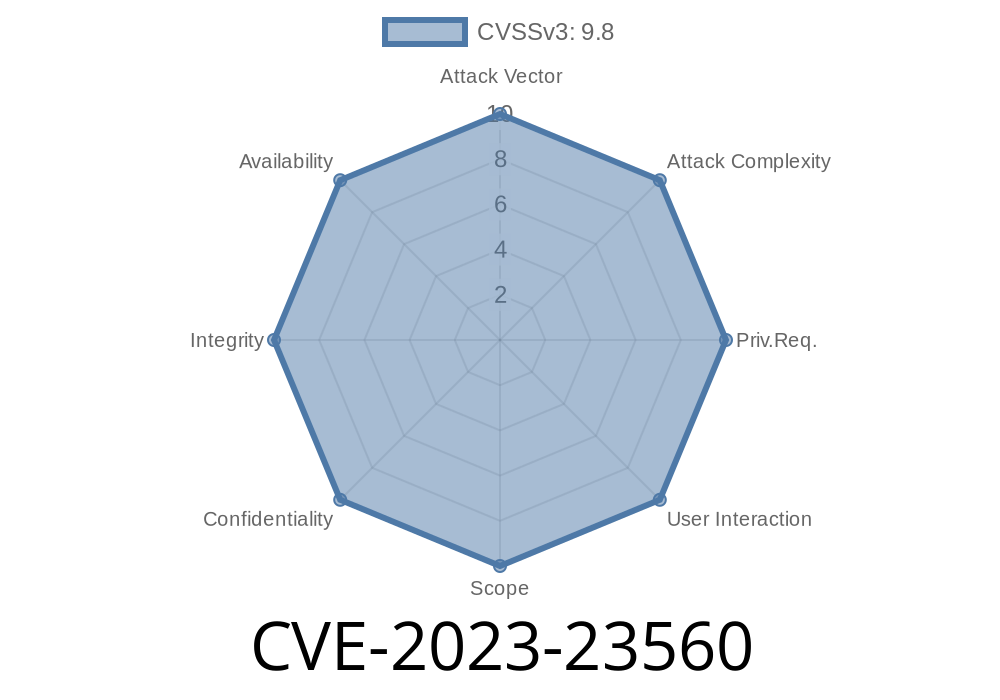Many offices use Lexmark printers daily, but few people consider that these hardworking devices can be targets for cyberattacks. In January 2023, a critical security vulnerability — CVE-2023-23560 — was revealed in certain Lexmark products. It’s a textbook case of a Server-Side Request Forgery (SSRF) bug caused by a lack of input validation in the device’s software.
In this post, we’ll break down what CVE-2023-23560 means, how the exploit works, and what you should do to stay safe. Even if you’re a beginner in IT and security, this guide is written for you.
Quick Summary
CVE ID: CVE-2023-23560
Date Published: 2023-01-12
Impact: SSRF (Server-Side Request Forgery)
Affected Products: Many Lexmark printers and devices
Severity: 7.5 (High)
Keywords: Lexmark, SSRF, printer security, input validation
What is SSRF?
SSRF stands for Server-Side Request Forgery. It’s a vulnerability where an attacker tricks a server (or device) into making HTTP requests to locations it shouldn’t — like internal networks, sensitive endpoints, or even to outside the organization.
For printers, this is extra sneaky because printers are often trusted on internal networks and may have access blocked from outside.
Example attack:
A hacker submits a request that makes your printer try to visit http://internal-bank-app.local/admin, leaking private data or even opening a door for more hacks.
The Root Cause: Bad Input Checks
The vulnerability — CVE-2023-23560 — comes down to the printer’s web interface not properly checking what URLs users can input.
Here’s a simplified code snippet to show how it might look in the device’s firmware
# Pseudocode: Unprotected handler for remote fetch
def fetch_url(user_supplied_url):
# NO CHECKS! (vulnerable)
response = http.request('GET', user_supplied_url)
return response.read()
Here, there is no validation of user_supplied_url, so a hacker can point it to any internal or external address.
The Exploit: Step by Step
1. Attacker Accesses Admin or User Portal
Most Lexmark printers have a web management portal (something like http://printer-ip-address/).
2. Attacker Finds the SSRF Feature
Some settings (e.g., “fetch firmware”, “load remote images”, “fax from URL”) take an arbitrary URL input.
The attacker submits a URL like
http://127...1/admin
http://192.168.1.20/secrets.json
http://metadata.google.internal/computeMetadata/v1/
4. Printer Requests the Malicious URL
The printer’s software, without validation, fetches the each endpoint on behalf of the attacker.
5. Attacker Gets the Response
Depending on how the printer displays the result, the attacker gets the *content*, sees if a port is open/closed, or learns details for future attacks.
Here’s a curl command that mimics what an attacker would do
curl -X POST \
-d "url=http://localhost/admin"; \
http://printer-ip-address/vulnerable_endpoint
What this does:
If the admin content is returned to the attacker, they can read private info.
Note: Actual endpoints and parameters depend on the specific printer model and firmware.
Original References and Advisories
- Lexmark Security Advisory *(PDF)*
- CVE-2023-23560 NIST NVD
- Lexmark Support Bulletin
Real-World Impact
- Data Leak: Hackers can use the printer to look for files and endpoints inside your network, like databases or admin panels.
How to Protect Your Lexmark Printer
- Update Firmware: Patch *immediately* — Lexmark has released updates that fix input validation on affected models.
- Network Segmentation: Keep printers in their own VLAN or subnet and block unnecessary outbound traffic.
Conclusion
CVE-2023-23560 is a classic example of why every device — even printers — needs secure coding practices. Input validation may sound boring, but skipping it can put entire networks at risk. Update your Lexmark devices right away and take network precautions. Protecting your printer protects your whole organization!
For more details and patch links, visit the official Lexmark security page.
*(This article is an exclusive, plain-language summary for understanding CVE-2023-23560 and SSRF in Lexmark printers.)*
Timeline
Published on: 01/23/2023 21:15:00 UTC
Last modified on: 02/08/2023 18:52:00 UTC
